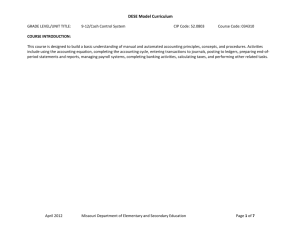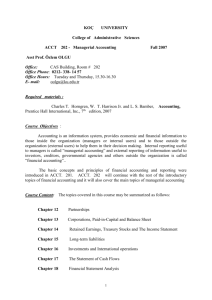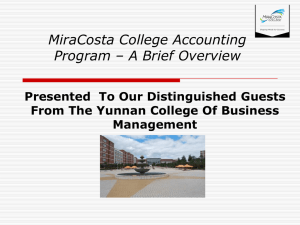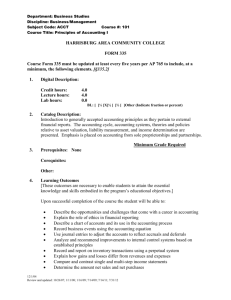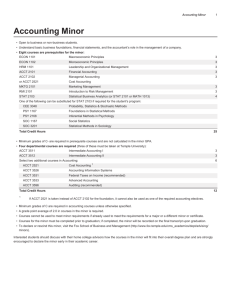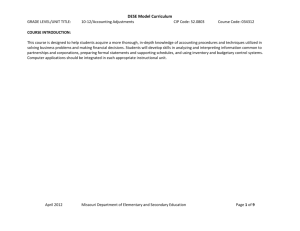doc
advertisement
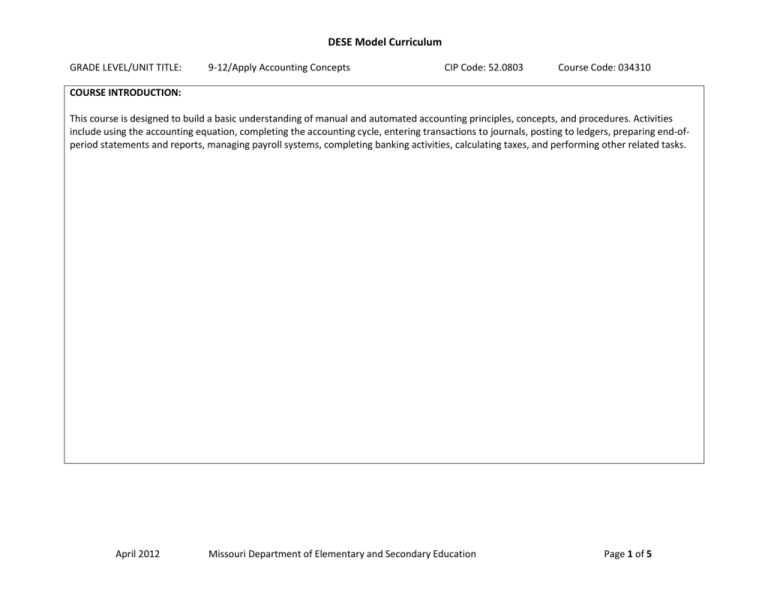
DESE Model Curriculum GRADE LEVEL/UNIT TITLE: 9-12/Apply Accounting Concepts CIP Code: 52.0803 Course Code: 034310 COURSE INTRODUCTION: This course is designed to build a basic understanding of manual and automated accounting principles, concepts, and procedures. Activities include using the accounting equation, completing the accounting cycle, entering transactions to journals, posting to ledgers, preparing end-ofperiod statements and reports, managing payroll systems, completing banking activities, calculating taxes, and performing other related tasks. April 2012 Missouri Department of Elementary and Secondary Education Page 1 of 5 DESE Model Curriculum GRADE LEVEL/UNIT TITLE: 9-12/Apply Accounting Concepts CIP Code: 52.0803 Course Code: 034310 UNIT DESCRIPTION: SUGGESTED UNIT TIMELINE: 4 weeks Students will learn the purpose of accounting, its principles, and how to apply the accounting equation to business transactions. CLASS PERIOD (min.): 50 MIN. ESSENTIAL QUESTIONS: A. How are account balances related to the accounting equation? B. What are basic accounting concepts? C. How do you create a double entry accounting transaction? ESSENTIAL MEASURABLE LEARNING OBJECTIVES CCSS LEARNING GOALS (Anchor Standards/Clusters) CROSSWALK TO STANDARDS GLEs/ CLEs 1. Explain the purpose of accounting 2. Explain the ethics associated with accounting practices. 3. Define terminology related to accounting concepts and principles 4. Define the three forms of ownership 5. Apply the accounting equation to business transactions April 2012 Missouri Department of Elementary and Secondary Education PS CCSS RI.11-12.4 SL.11-12.1 RI.11-12.4 SL.11-12.1 RI.11-12.4 RST.11-12.4 RH.11-12.4 L.11-12.6 RI.11-12.4 RST.11-12.4 RH.11-12.4 L.11-12.6 RI.11-12.7 RST.11-12.1 NBEA DOK ACCT.V.3-4.1 2 ACCT.I.3-4.3 2 ACCT.IV.A.3-4.1 1 ACCT.II.3-4.14 1 ACCT.V.3-4.6 3 Page 2 of 5 DESE Model Curriculum GRADE LEVEL/UNIT TITLE: 9-12/Apply Accounting Concepts CIP Code: 52.0803 6. Classify accounts 7. Utilize a chart of accounts 8. Explain the importance of following the Accounting Concepts/ Generally Accepted Accounting Principles (GAAP) 9. Explain the double entry system of accounting Course Code: 034310 RST.11-12.3 N-Q.1 A-CED.1 RST.11-12.1 ACCT.IV.A.3-4.2 SL.11-12.1 ACCT.II.3-4.9 RST.11-12.1 ACCT.IV.A.3-4.2 ACCT.II.3-4.9 L.11-12.6 ACCT.IV.A.3-4.1 SL.11-12.1 L.11-12.6 SL.11-12.1 L.11-12.6 ACCT.V.3-4.7 2 2 3 2 10. Apply debit and credit rules to business ACCT.V.3-4.7 4 transactions ASSESSMENT DESCRIPTIONS*: (Write a brief overview here. Identify Formative/Summative. Actual assessments will be accessed by a link to PDF file or Word doc. ) Utilize South-Western textbook objective tests (summative) Utilize South-Western textbook performance tests (summative) Debit/Credit/Normal Balance Quiz (formative) *Attach Unit Summative Assessment, including Scoring Guides/Scoring Keys/Alignment Codes and DOK Levels for all items. Label each assessment according to the unit descriptions above ( i.e., Grade Level/Course Title/Course Code, Unit #.) Obj. # INSTRUCTIONAL STRATEGIES (research-based): (Teacher Methods) 1-10 1. The teacher will present new material in small steps, model and provide guided practice, review the material, question students to connect new material to prior learning, check for understanding, and then monitor guided practice for manipulating accounting equations. 3, 6 2. The teacher will present new material in small steps, model and provide guided practice, review the material, question students to connect new material to prior learning, check for understanding, and then monitor guided practice for classifying accounts as assets, April 2012 Missouri Department of Elementary and Secondary Education Page 3 of 5 DESE Model Curriculum GRADE LEVEL/UNIT TITLE: 9-12/Apply Accounting Concepts CIP Code: 52.0803 Course Code: 034310 liabilities, and owner’s equity. 3, 5, 10 3. The teacher will present new material in small steps, model and provide guided practice, review the material, question students to connect new material to prior learning, check for understanding, and then monitor guided practice for identifying debit, credit, and normal balances of accounts. 3, 5, 9, 10 4. The teacher will present new material in small steps, model and provide guided practice, review the material, question students to connect new material to prior learning, check for understanding, and then monitor guided practice for analyze and record the debit/credit parts of transactions affecting the accounting equation. 1, 3, 4, 8 5. The teacher will present new material in small steps, model and provide guided practice, review the material, question students to connect new material to prior learning, check for understanding, and then monitor guided practice for identify accounting concepts related to starting a service business organized as a proprietorship. 3, 6, 7 6. The teacher will present new material in small steps, model and provide guided practice, review the material, question students to connect new material to prior learning, check for understanding, and then monitor guided practice for creating a chart of accounts. Obj. # INSTRUCTIONAL ACTIVITIES: (What Students Do) 1-10 1. The student will be able to manipulate the accounting equation to find the missing variable and balance the equation. 3, 6 2. The student will be able to classify accounts as assets, liabilities, and owner’s equity. 3, 5, 10 3. The student will be able to identify the debit, credit, and normal balances of accounts. 3, 5, 9, 10 1, 3, 4, 8 4. The student will be able to analyze and record the debit/credit parts of transactions affecting the accounting equation. 3, 6, 7 6. The student will create a chart of accounts. 5. The student will be able to identify accounting concepts related to starting a service business organized as a proprietorship. UNIT RESOURCES: (include internet addresses for linking) South-Western Accounting April 2012 Missouri Department of Elementary and Secondary Education Page 4 of 5 DESE Model Curriculum GRADE LEVEL/UNIT TITLE: 9-12/Apply Accounting Concepts CIP Code: 52.0803 Course Code: 034310 Collin Dodds Debit Credit Theory (YouTube Video) www.dwmbeancounter.com www.Quia.com www.superteachertools.com (Jeopardy Game) Resources @MCCE: BE DVD ROM 34 - On the Money: The ABCs of Accounting Introductions and Definitions - Cambridge Educational, LAWRENCEVILLE, NJ, CAMBRIDGE EDUCATIONAL, 2002. When it comes to finances, "approximately" is just not good enough. Accounting professionals are expected to understand all the ins and outs of money matters, applying the rules of accountancy with good sense and care. With that in mind, this program starts with the basics, introducing the purpose of accounting, identifying the AICPA and FASB, explaining the concept of GAAP, and spelling out the differences between CPAs and CMAs. After contrasting three types of business organizations, the program moves on to the actual process of recording and tracking transactions. 15 minutes. BE 13.1303 T171 - Games Accounting Teachers Play - Joy Tavano, Editor, WARWICKM RI, BUSINESS EDUCATION PUBLISHING, 2006. This book includes a collection of games, activities, and strategies--from debits and credits and T-accounts to journalizing entries and the accounting equation. Organized into six accounting instructional categories: Bulletin boards and visual reinforcements; Classroom discussion generators; Accounting games; Hands-on activities; Creative projects and assessments; Accounting teaching tips and resources. BE DVD ROM 13.1 - Profit & Loss Statement - Sunburst Visual Media, PLAINVIEW, NY, SUNBURST VISUAL MEDIA, 2001. Math is the basis for this BUSINESS BASICS (TM) program presenting important accounting analysis. Students are presented with information about revenues, cost of goods sold, gross profit, expenses, net profit and more. Grades 9 to 12. 30 minutes. April 2012 Missouri Department of Elementary and Secondary Education Page 5 of 5

